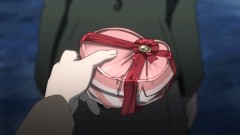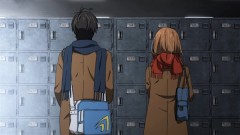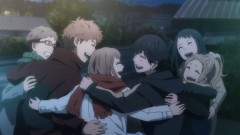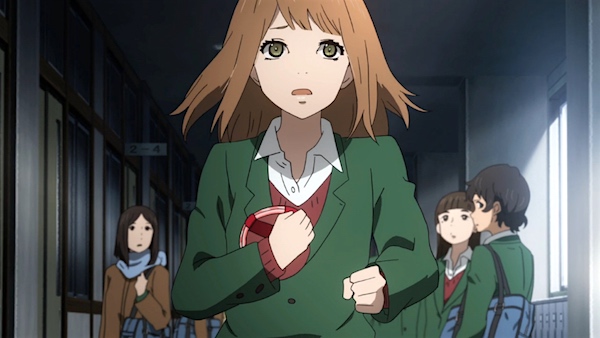
The Wheels of Fate turn and the destined day arrives where either Kakeru will be saved or lost (again).
What They Say:
Episode 13: LETTER 13
The Review:
Content: (please note that content portions of a review may contain spoilers)
It probably comes as no surprise that any kind of description for this episode would essentially spoil the author’s resolution of the central conundrum that has provided the foundation for this story: will the group of friends succeed in changing Kakeru’s fate? All I will say on that score is that the result is probably what most people have been expecting at this point, even if there are still twists and turns thrown at us. That half of the final episode also encompasses a standard Valentine’s Day chocolate story (curse the Chocolate-cracy that rules Japanese High Schools on 2/14!) just shows how much even a somewhat serious show must bow before the tropes and conventions of the setting chosen for this tale. Of course, the date matters as well as it is the day before Kakeru dies in the original timeline.
Now that it’s over and settled, it’s time to take stock of the overall concept and execution, both for the story as a whole and in how this final resolution is crafted. The problem with time travel stories is that they often take shortcuts or otherwise bend “the rules” (of the Universe as we experience it) in order to fashion the end results the authors wish. While many creators are familiar enough with the basic concepts that even most laymen know, about the nature of basic time paradoxes, very few make any serious attempt to grapple with temporal mechanics and the problems with traveling through time or altering a timeline from a later point in it. I’m not a physicist but know enough to see handwaving and fudging when I see it. On that score, I can give Ichigo Takano quite a bit of credit as she does raise the various issues that can be involved in trying to change the past.

Hagita, who wears glasses and thus must be the “smart” one of the group, raises the various problems involved in trying to change the past and the ethical issues involved as well. In this final installment, the Future Hagita states that changing the past is impossible, as success in saving Kakeru would remove their regrets and they would never have written the letters to the past that saved Kakeru. Success means the letters would no longer exist in their world, as there would have been no need to write them, but then their past selves would not be informed of what would happen and events would simply repeat. Their past is fixed. How then to save Kakeru? From high school, their science teacher (back in Episode 5) laid out the “Many Worlds” theory (which is a real scientific theory) and how one can change a past to create a new future. And that is the best the group can do: they can send letters to their past selves and create a new world where they save Kakeru. He will always remain dead in the world of the letter writers. The Past truly is written in stone. Little Suwa’s existence is safe. But Kakeru might yet live in an alternate timeline.

While that part of the story is on a sound footing…there is still the question of how they sent the letters back, which is not shown in the anime (I have not read the manga, so I have no idea if the issue is addressed there). So, while some credit can be advanced for recognizing that the Past is fixed and that all they can do, at best, is to create a branch off point into a new timeline where Kakeru may live, we can also deduct some points for handwaving the mechanism of transmission (in the earlier episode where they talked about taking their letters to the Bermuda Triangle where there allegedly could be a black hole…that’s one of the most far-fetched ideas I think I have come across in fiction. If there were a black hole in the Bermuda Triangle, even a very tiny one, the effects would be so noticeable that it could hardly remain hidden or undetected. Further, black wholes, regardless of size, are objects of such incredible mass, could anyone actually believe that it could move along with the Earth as the planet rotates, not changing position?).
Enough science. Most people are probably more interested in the characters and the love story at the heart of it than the finer points of speculative temporal mechanics. In terms of personalities, the ones present here are fairly stock portraits of types commonly found in manga. Naho is the wallflower female protagonist, quite ubiquitous in shoujo manga; Kakeru is an emo teen boy; Suwa is the noble jock who is self-sacrificing beyond credibility; Hagita is the “brain,” Takako is the cool and reliable type while Azusa is the fun, free-spirited kind. If there are some points to criticize, it is that the “lesser trio” of Hagita, Takako, and Azusa feel incomplete for the most part. We never really get to learn all that much about them and find out what makes them tick. Their stories and lives seem peripheral to the triangle of Kakeru-Naho-Suwa.
The “main three,” however, are fleshed out enough to make the show work. There are some elements that can be frustrating and strain credibility a bit. Naho’s hesitancy caused ire more than once. Kakeru’s self-loathing varied: at times, quite credible; at other points, it seemed more there for the author’s convenience than from any kind of natural suitability. Suwa, as I noted above, is self-sacrificing, willing to give up his dream of a happy future with Naho, to an extent that seems slightly hard to believe. I can only assume that his letter from his future self was quite explicit about what the “costs” were for his dream future to come into being.

But on the more positive side, the group dynamics and much of Kakeru’s behavior, once we had the revelations about his inner life in the previous episode, all had a level of believability that served the story well. The psychological states of Kakeru and Naho are drawn in some detail, fairly credible detail. While the behavior of the two of them could be frustrating at times, one can understand why Kakeru was withdrawn and did not want to seriously date anyone (his rejection of his mother and her death over it made him a guilt-ridden mess and he was unwilling to forgive himself). And one can see Naho’s inability to break out of her own shell because that’s her nature: the shy type who lacks any confidence or courage. What probably needed to happen more than anything else in order to save Kakeru would be for Naho to break out of her own self-limiting prison of doubt and reticence. Whether she did or not by the end, one may judge for oneself.
As has been noted by many, there were some points during the season where the animation and artwork took a dip (some would say a dive). That shortcoming did not have quite as much impact on me, since I was never watching this show for the visuals, but for the story and the characters. Those are the strongest aspects of the show. Of course, one might have questions about Orange having any rewatch value once one has learned all of its secrets. Perhaps, in order to check up and see how well the show works from the start to its ending.
For that ending itself, in terms of wrapping up the story it does what it needs to do, even if the extra long final installment (the running time comes out to about one and a half standard full-length episodes) does not exactly feel like it needed all of that running time. The lead up to the final climax was pretty well planned, leaving one guessing as to whether Kakeru would be save or not. Though one does wonder a bit what Naho sees in a boy who is very much prone to massive mood swings and at the whim of his own emotions to the point where he could smile one day and decide to end his existence on the next, all because of a chance discovery or revelation.
Orange is not the usual kind of show that I enjoy, but as a tale of the bonds of friendship and the price of regret, it was pretty good. There is genuine heart at the root of this tale.
In Summary:
It’s Valentine’s Day, so time for chocolate (though poor Suwa and Hagita don’t even get obligatory chocolate from any of their female friends) and the usual romantic cliches. But it’s also the important decision day for the group as they know that Kakeru is fated to die on the morrow unless they can find a way to bend his path away from that destiny. Will the group succeed? All is revealed in the end.
Grade: A-
Streamed By: Crunchyroll
Review Equipment:
Apple iMac with 12GB RAM, Mac OS 10.11 El Capitan.





